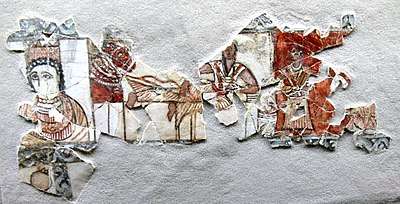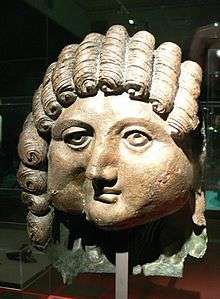Kindah
Kindah (Arabic: كِنْدَة) was a tribal kingdom in central Arabia established by the Kindah tribe which emigrated from its homeland in Yemen.[1] The tribe's existence dates back to the 2nd century BCE.[2] The Kindites established a kingdom in central Arabia which was unlike those of Yemen that were more centralized; its kings exercised an influence over a number of associated tribes, more by personal prestige than by coercive settled authority. Their first capital was Qaryat Dhāt Kāhil, today known as Qaryat al-Fāw.[1]
| Historical Arab states and dynasties | ||||||||||||||||||||||||||||||||||||||||||||||||||||||||||
|---|---|---|---|---|---|---|---|---|---|---|---|---|---|---|---|---|---|---|---|---|---|---|---|---|---|---|---|---|---|---|---|---|---|---|---|---|---|---|---|---|---|---|---|---|---|---|---|---|---|---|---|---|---|---|---|---|---|---|
 | ||||||||||||||||||||||||||||||||||||||||||||||||||||||||||
|
Ancient Arab States
|
||||||||||||||||||||||||||||||||||||||||||||||||||||||||||
|
Arab Empires
|
||||||||||||||||||||||||||||||||||||||||||||||||||||||||||
|
Eastern Dynasties
|
||||||||||||||||||||||||||||||||||||||||||||||||||||||||||
|
Western Dynasties
|
||||||||||||||||||||||||||||||||||||||||||||||||||||||||||
|
Arabian Peninsula
|
||||||||||||||||||||||||||||||||||||||||||||||||||||||||||
|
East Africa
|
||||||||||||||||||||||||||||||||||||||||||||||||||||||||||
|
Current monarchies
|
||||||||||||||||||||||||||||||||||||||||||||||||||||||||||
Kingdom of Kindah مملكة كندة | |||||||||
|---|---|---|---|---|---|---|---|---|---|
| 425 CE–6th century CE | |||||||||
 | |||||||||
| Capital | Qaryat al-Faw | ||||||||
| Common languages | Arabic | ||||||||
| Religion | Arab Polytheism | ||||||||
| Government | Monarchy | ||||||||
| History | |||||||||
• Established | 425 CE | ||||||||
• Disestablished | 6th century CE | ||||||||
| |||||||||
The Kindites were polytheistic until the 6th century CE, with evidence of rituals dedicated to the deities Athtar and Kāhil found in their ancient capital in south-central Arabia (present day Saudi Arabia). There is a strong archaeological evidence that they were among the tribes in Dhū Nuwās' forces during the Jewish king's attempt to suppress Christianity in Yemen.[3] They converted to Islam in mid 7th century CE and played a crucial role during the Muslim conquests of their region, although some sub-tribes were declared apostates during the false prophet wars after the death of Muhammad. Most of the tribes adopted Wahhabism after the rise of the House of Saud.


Origin
Ancient South Arabian inscriptions mention a tribe called kdt, who had a king called rbˁt (Rabi’ah) from ḏw ṯwr-m (the people of Thawr), who had sworn allegiance to the king of Saba’ and Dhū Raydān.[4] Since later Arab genealogists trace Kindah back to a person called Thawr ibn ‘Uqayr, modern historians have concluded that this rbˁt ḏw ṯwrm (Rabī’ah of the People of Thawr) must have been a king of Kindah (kdt); the Musnad inscriptions mention that he was king both of kdt (Kindah) and qhtn (Qaḥṭān). They played a major role in the Sabaean-Hadramite war.
The first Classical author to mention Kindah was the Byzantine ambassador Nonnosos, who was sent by the Emperor Justinian to the area. He refers to the people in Greek as Khindēnoi (Greek Χινδηνοι, Arabic Kindah), and mentions that they and the tribe of Maadēnoi (Greek: Μααδηνοι, Arabic: Ma’ād) were the two most important tribes in the area in terms of territory and number. He calls the king of Kindah Kaïsos (Greek: Καισος, Arabic: Qays), the nephew of Aretha (Greek: Άρεθα, Arabic: Ḥārith).
Migration from Yemen
After the collapse of the Ma'rib Dam and the Ḥimyarite's final annexation of Saba'a, the Kindites headed towards ancient Bahrain but were expelled by the 'Abd al-Qays tribe. The Kindites returned to Yemen, leaving a branch of Kindah in modern Jabal Shammar in Najd, the Levant and Iraq.[5]
Return to Yemen
When some of the Kindites returned to Yemen in the 4th century AD, the Himyarites were at the height of their power, having annexed Hadramout, the last rival South Arabian kingdom. The Kindites had historic feuds with the Hadramite tribes of the southern Wadi, so they were settled in Northern Hadramout and were given authority over Hadramout by the Himyarites. From this point on, some Arab historians consider Kindah to have been part of the Himyar tribal federation.
Kindite kings in Hadramout 325AD–425AD
- Muwiyah Ibn Mutri
- Murti ibn Muawiyah
- Muawiyah ibn Thaur
- Amr ibn Muawiyah
- Muawiyah ibn Rabiah
- Hijr Ibn Muwaiyah
Expansion towards Northern Arabia
In the 5th century CE, the tribes of North Arabia became a major threat to the trade line between Yemen and Syria. The Ḥimyarites decided to establish a vassal state that controlled Central and North Arabia. The Kindites gained strength and numbers to play that role, and in 425 CE the Ḥimyarite king Ḥasan ibn 'Amr ibn Tubba’ made Ḥujr 'Akīl al-Murār ibn 'Amr the first King (Ḥujr) of Kindah.
Wars with the Lakhmid
In that period the Ghassānids, Lakhmids and Kindites were all Kahlānī and Qaḥṭānī vassal kingdoms appointed by the Byzantines, Persians and Ḥimyarites to protect their borders and imperial interests from the raids of the then-rising threat of the 'Adnānī tribes. In the 5th and 6th centuries CE the Kindites made the first real concerted effort to unite all the tribes of Central Arabia through alliances, and focused on wars with the Lakhmids. Al-Ḥārith ibn 'Amr, the most famous of their kings, finally succeeded in capturing the Lakhmid capital of al-Ḥirah in southern modern day Iraq.[6] Later however in about 529, al-Mundhir recaptured the city and put King Ḥārith and about fifty members of the royal family to death.
The fall of Ḥimyar
In 525 CE, the Aksumites invaded Ḥimyar, and this had a knock-on effect with the Kindites who lost the support of the Ḥimyarites. Within three years the Kindite kingdom had split into four groups: Asad, Taghlib, Qays and Kinānah, each led by a prince of Kindah. These small 'principalities' were then overthrown in the 530s and 540s in a series of uprisings of the 'Adnānī tribes of Najd and Ḥijāz.[7]
Imru' Al-Qais
Among the most famous Kindites is Imru' al-Qays, who was not only a son of one of the last Kindite kings (and unsuccessfully tried to resurrect his father's kingdom), but also the most prominent pre-Islamic Arab poet. It was during Al-Qais' time, in 540 CE, that the Lakhmids destroyed all the Kindite settlements in Najd, forcing the majority of them to move to the Yemen. The Kindites and most of the Arab tribes switched their alliances to the Lakhmids.
Jewish conversion
The Kindites converted to Judaism following the conversion of the Himyarite kings in the late 5th century CE most notably the Banu al-Harith of Najran. However, Kindite Judaism was weakened by the rise of the Christian Aksumites in Yemen at around 525 CE.
Descendants of the Kindites
Today, most people of Kindite ancestry live in Yemen, Oman, Saudi Arabia, Jordan, Iraq and the United Arab Emirates.[8]
References
- History of Arabia – Kindah. Encyclopædia Britannica. Retrieved 11 February 2012.
- D. H. Müller, Al-Hamdani, 53, 124, W. Caskel, Entdeckungen In Arabien, Köln, 1954, S. 9. Mahram, p. 318
- Le Muséon, 3-4, 1953, P.296, Bulletin Of The School Of Oriental And African Studies, University Of London, Vol., Xvi, Part: 3, 1954, P.434, Ryckmans 508
- Jamme 635. See: Jawād 'Alī: Al-Mufaṣṣal fī Tārīkh al-'Arab Qabl al-Islam, Part 39.
- "Kindah | people". Encyclopedia Britannica.
- "Kindah | people". Retrieved 5 August 2016.
- Korotayev A.; Klimenko V.; Proussakov D. "Origins of Islam: Political-Anthropological and Environmental Context". Acta Orientalia Academiae Scientiarum Hungaricae. 53 (3–4): 243–276.
- Al Owtabi Al Sohari, Salama bin Muslim (1994). Al Ansaab Part 1. Muscat: Ministry of Heritage and Culture, Oman. p. 392.
External links
- Encyclopædia Britannica article on Kindah
- For a preview of: "Towards the earliest history of Kinda" by M.D. Bukharin. Arab. arch. epig. 2009: 20: 64–80 (2009) go to: Towards the earliest history of Kinda